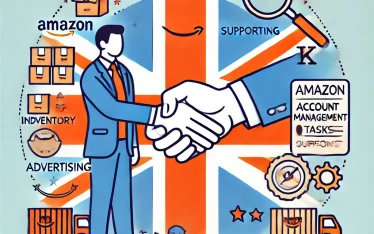TL;DR
- Start small with the Individual plan or go big with the Professional plan—easy to switch anytime!
- Enter basic info like your business email, credit card, and VAT number, and you’re all set to sell.
- Don’t forget referral, fulfillment, and storage fees! Plan for these costs to stay profitable.
- UK sellers start fresh, US sellers can reuse content but adjust for local differences like measurements and cultural references.
- Create PPC campaigns, improve your listings, and keep growing your brand to stay ahead in the UK market.
If you’re a new seller in the UK or a US-based seller about to branch out into the UK, you’ll probably need some guidance on how to navigate Amazon’s UK marketplace.
When you register to sell on Amazon UK, you’re not just limited to one country—you automatically sell to all five European marketplaces, including:
- Amazon Spain (Amazon.ES)
- Amazon Germany (Amazon.DE)
- Amazon Italy (Amazon.IT)
- Amazon France (Amazon.FR)
- Amazon Netherlands (Amazon.NL)
Didn’t know that? Well, now you do! And that’s just the start. In this blog post, we’ll cover this and much more. Keep reading—it’s easier than you think!
Quick guide
- Step 1: Choose your plan
- Step 2: Complete your registration
- Step 3: Calculate the total costs to sell on Amazon UK
- Step 4: Start listing your products on Amazon
- Step 5: Optimise your product listings
- Step 6: Advertise and optimise
Step 1: Choose your plan
The first step is choosing the plan that fits your business. Amazon gives you two options: the Individual plan or the Professional plan.
| Plan | Best for | Cost | Features |
| Individual Plan | Selling fewer than 35 items per month | 75p per sale | – No advanced tools
– Great for starting small – Easy switch later |
| Professional Plan | Selling more than 35 items per month | £25 per month (unlimited sales) | – Access to advanced tools & reports
– APIs available – Includes programs like Handmade |
So, how do you choose? If you’re starting small, go for the Individual plan. If you’re selling more, the Professional plan gives you access to extra tools and features like selling reports and access to cool programs like Handmade.
But don’t stress—if you change your mind, you can switch plans anytime. And just remember, additional selling fees apply to both plans, so factor those in as well!
Step 2: Complete your registration
Now that you’ve decided on your selling plan, head over to the sale on Amazon UK site and click the “Sign up” button.
Next, enter the credentials you’d like to use for your account.
To complete the signup process, Amazon will require the following details:
- Business email address or your Amazon customer account
- A chargeable credit card (don’t worry, international cards are accepted!)
- Valid passport or ID (Amazon’s identity check protects both sellers and customers)
- Company registration details, including your VAT number if applicable
What’s a VAT number, and do I need one?
Good question! If you’re selling goods in any European country, you’ll probably need to register for Value Added Tax (VAT). VAT is a tax that’s added to the price of goods and is then passed on to the tax authorities when you file your returns. The good news? You may be able to claim back some of that VAT. It’s a bit of a hassle, but it’s all part of doing business in Europe!
Once you’ve filled in all the necessary info, Amazon will verify your account. Don’t worry, it’s just a quick security check before they give you the green light to start selling. After you’re approved, you can jump straight into listing your products and start making sales!
Step 3: Calculate the total costs to sell on Amazon UK
To calculate the total costs of selling on Amazon UK, you’ll need to account for several key fees that vary depending on your selling plan, product category, fulfilment method, and any additional services like advertising. Here’s a breakdown:
1) Selling plan fees:
- Individual plan: 75p per item sold, great for low-volume sellers (less than 35 items per month).
- Professional plan: £25 per month regardless of how many items you sell, ideal for higher-volume sellers.
2) Referral fees:
Referral fees are a percentage of your item’s sale price, including shipping and gift-wrapping charges. These typically range from 8% to 15%, depending on the product category. For example:
- Electronics: 8%
- Beauty & Health: 15.3%
- Books: 15.3% plus a closing fee
3) Fulfilment fees:
Fulfilled by Amazon (FBA): This fee depends on the size and weight of your product. For instance, standard items weighing up to 960g cost around £2.58 per unit. Larger items, or those requiring special handling, cost more.
Fulfilled by Merchant (FBM): Here, you handle shipping yourself, and Amazon charges a small shipping fee depending on the product category and shipping destination.
4) Storage fees:
Amazon charges storage fees per cubic foot. Fees increase during peak months (October-December), ranging from £0.75 per cubic foot for standard items in non-peak months to £2.40 per cubic foot during the holiday season.
5) Additional costs
- Advertising costs: If you run ads on Amazon, you’ll need to budget for advertising spend on top of these fees.
- VAT and currency conversion: UK sellers must handle VAT, and if you’re selling internationally, there may be currency conversion fees.
Step 4: Start listing your products on Amazon
When you’re ready to start listing products on Amazon UK, the process varies slightly depending on whether you’re a UK-based seller listing new products or a US-based seller expanding into the UK marketplace.
For UK-based sellers listing new products:
- UK-based sellers can easily create new listings from scratch by logging into Amazon Seller Central UK. You’ll need to provide basic product details, such as title, description, pricing, and images. Hire a professional Amazon product listing optimization agency to get things done easily.
- Use product identifiers like EAN, UPC, or ISBN codes, or request an exemption if necessary. You’ll also need to follow UK-specific product regulations.
For USA-based sellers expanding into the UK:
- Build International Listings (BIL) Tool: If you already sell on Amazon USA, you can use the Build International Listings (BIL) tool. This tool helps you easily replicate your existing product listings from the US into the UK marketplace. However, you’ll need to adjust certain things, like pricing (which doesn’t automatically convert) and compliance with UK product regulations.
- Listing adjustments: Ask your Amazon SEO professional to review UK-specific rules and modify descriptions, measurements (from inches to cm), and VAT compliance details. For example, some words that may be acceptable in the US might not comply with UK policies.
By using tools like BIL and understanding local requirements, US-based sellers can streamline the process of expanding into the UK without needing to relist everything from scratch. But it’s essential to double-check for localization issues, such as currency, keywords, and compliance.
Step 5: Optimise your product listings
Now that you’re listing your products on Amazon UK, it’s time to optimise! Here’s how to tackle it, whether you’re starting from scratch or relisting your products from the USA.
If you’re listing new products in the UK:
You’ll need to create everything from scratch—content, images, A+ Content, Amazon brand store design, and a brand story. It’s important to follow Amazon’s common rules to ensure your listing is compliant:
- Product title: Clear, concise, and with relevant keywords.
- Bullet points & descriptions: Focus on benefits and key features.
- Images: High-quality images that showcase the product from all angles.
- A+ Content: Enhances the product story with banners, comparisons, and visuals.
- Storefront & Brand Story: Make sure your storefront reflects your brand’s values and connects with UK customers.
If you’re relisting USA products:
You can reuse most of your content and creative assets like images, A+ Content, and descriptions from your USA listings. But here’s the catch—you might need to make a few adjustments. For example:
- Cultural references: Adjust phrases like “Thanksgiving” to something more relevant in the UK, such as “Christmas.” Keep in mind that they say Father Christmas instead of Santa Claus.
- Measurements: Convert inches to centimetres or pounds to kilograms.
- Spelling and language: Ensure you use British English (e.g., “colour” instead of “colour”).
Working with an Amazon optimization consultant can help you make these adjustments smoothly, ensuring your listings are fully optimised for the UK market while avoiding common pitfalls. It’s all about fine-tuning to match local expectations.
Step 6: Advertise and optimise
Once your listings are live, the next steps are the same for every marketplace. But let’s make sure we’re not just doing things halfway—this is where you go full throttle.
1) Create winning campaigns
Once your products are listed, find an Amazon advertising agency to push them in front of the right audience. Start creating Amazon PPC campaigns to boost visibility. Whether it’s Sponsored Products or Sponsored Brands, these campaigns help drive traffic to your listings, putting you directly in front of shoppers. Remember, Amazon is a busy marketplace, and ads help you cut through the noise.
2) Build your brand
Building a brand on Amazon goes beyond just listing products. You need to make sure your customers recognize, trust, and return to your brand. How do you do this? Through a strong storefront, consistent branding across your listings, and engaging A+ Content that tells your brand story. The more familiar your brand feels, the more likely customers are to pick you over the competition. It’s a long game, but the payoff is worth it.
3) Sell more, scale more
As you gain traction, start looking at ways to scale your business. Add new products, explore Amazon’s international marketplaces, and expand your FBA strategy to manage higher demand. It’s all about scaling smart—one step at a time.
4) Fix what’s broken, optimise what works
No process is perfect, and that’s okay. What separates top sellers from the rest is their ability to fix mistakes quickly. Check your performance regularly—whether it’s addressing negative feedback, refining ad strategies, or updating product descriptions to reflect customer needs.
5) Keep selling
It’s all about momentum. Keep your listings optimised, keep running campaigns, keep engaging with customers, and most importantly—keep selling. This is the rinse-and-repeat cycle of success on Amazon. Every time you improve a little, you sell more, build a stronger brand, and grow your business.
See you next week
Selling on Amazon UK becomes a whole lot smoother when you’ve got the right partner by your side. That’s where eStore Factory steps in! Our UK team is made up of local copywriters and Amazon experts who understand the UK marketplace. They know exactly what works, from crafting compelling product descriptions to navigating UK-specific regulations.
Whether you’re an Amazon seller in the US looking to break into the UK market or a UK-based retailer making your debut on Amazon, we’ve got your back. We know the ins and outs of the marketplace, and we’re here to make your selling journey easier and more successful.









